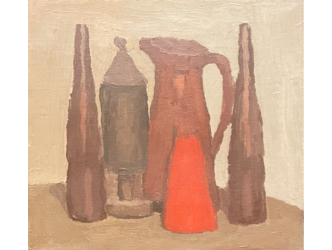Without paint
For centuries, art was the result of an almost identical action: applying layers of paint with varying degrees of thickness to produce forms and create artworks. The American artist Mark Bradford has broken with tradition: he makes works without paint, using materials that clump together on the canvas before blasting off parts of the surface.
Ghosts of forms

The result is astonishing. Firstly because it demonstrates his virtuosity in terms of colour, but also because his abstract compositions, which are often in XXL format, seem to be carrying the ghosts of forms. In this respect, the exhibition running until 19 June at the Serralves Museum in Porto is an eloquent example.
A star in USA

The visual impact is powerful. It is the artist’s first major European institutional show, if we exclude the American pavilion when he represented his country at the Venice Biennale in 2017 . I interviewed Mark Bradford in 2017 in Venice. He spoke about his whispered messages.
Mark Bradford is a star in the United States. American museums like Lacma in Los Angeles, his hometown, and the Hirshhorn in Washington possess some of his major monumental artworks.
Philippe Vergne
His new obsessions are on show in Porto, featuring canvases that can measure up to 14 metres long. As the director of the Serralves Museum Philippe Vergne explains, Bradford tells stories through his paintings in a fragmented way: “they draw on the past and current violence in American society”.
15th century tapestries

In this instance he has developed a passion for representations of a series of mythical tapestries from the 15th century which belong to the Metropolitan Museum in New York: the hunt of the unicorn. He’s used this iconography depicting the hunt of this dreamlike creature to construct his works.
Like Courbet

Mark Bradford (detail)
Like Courbet in the 19th century who painted hunting scenes in which the animal symbolized the artist, Bradford shows, in his own way, “the hunt of the other, the foreigner, the vulnerable”, all the contemporary George Floyds, in Philippe Vergne’s analysis. To do so he uses a reproduction of the unicorn which he covers in overlapping layers of coloured paper, magazine pages and comics, as well as leaflets, mixing them with liquid glue, and then attaching various materials, such as rope.
Modelling and corrosion

In a second phase he blasts away some of this material using a high pressure washer. It is this process of both modelling and corrosion that produces a unique result. Certain forms, of a hunter or a fountain, thus emerge from the midst of the mass of materials. In another room, to describe a city, he uses posters as a base, for example those of Los Angeles.
Soft colours and lyrical aspect

Mark Bradford (detail)
The result is unexpected: from afar the viewer thinks they can recognize a kind of post-impressionist painting with soft colours and a lyrical aspect. Up close, the mass of materials reveals the process.
Fertile social ground of modern-day America
Bradford’s art, which has been uniquely strengthened in recent years, is innovative because of its process of fabrication, its visual power, but also because it takes as its source, discreetly yet effectively, the fertile social ground of modern-day America.

Until 19 June. Serralves Museum. Porto. https://www.serralves.pt/
Support independent news on art.
Your contribution : Make a monthly commitment to support JB Reports or a one off contribution as and when you feel like it. Choose the option that suits you best.
Need to cancel a recurring donation? Please go here.
The donation is considered to be a subscription for a fee set by the donor and for a duration also set by the donor.




